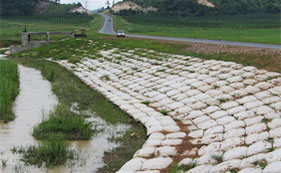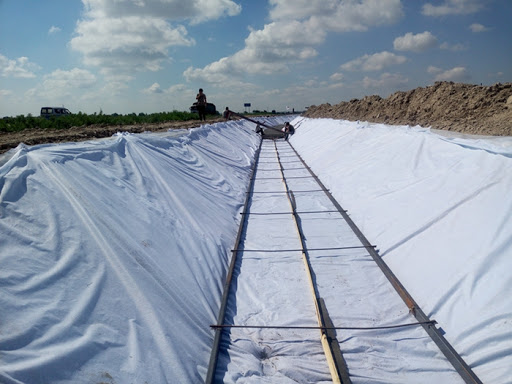
 Back to List
Back to List

一. Technical requirements for laying HDPE geomembrane
1. Before cutting the HDPE film, the relevant size should be accurately measured, and then cut according to the actual size. Generally, it is not suitable to cut according to the size shown. It should be numbered piece by piece and recorded in detail on the special form.
2. When laying HDPE geomembrane, the welds should be minimized, and raw materials should be saved as much as possible under the premise of ensuring quality. It is also easy to ensure quality.
3. The overlap width of the seam between the film and the film is generally not less than 10cm, and the welding seam is usually arranged in parallel to the maximum slope, that is, along the slope direction.
4. Usually in corners and deformed areas, the length of the joint should be as short as possible. Except for special requirements, on slopes with a slope greater than 1:6, within 1.5 meters from the top slope or stress concentration area, there should be no welds as far as possible.
5. When laying HDPE geomembrane, avoid artificial wrinkles. When the temperature is low, it should be tightened and flattened as much as possible.
6. After the HDPE geomembrane is laid, it is necessary to minimize walking and moving tools on the surface of the membrane. Anything that can cause harm to the HDPE membrane should not be placed on the membrane or carried on the membrane to avoid damage to the membrane. Cause accidental damage.
7. Sufficient material should be reserved at the top of the slope to be fixed with anchor trenches.
二. Precautions for welding of geomembrane
1. The welding process of the thermal welding machine is divided into: adjusting pressure → setting temperature → setting speed → welding seam overlap inspection → installing film into the machine → starting the motor → pressure welding.
2. There should be no oil and dust at the joints, and there should be no debris such as mud and sand on the overlapping section of the HDPE geomembrane. When there is debris, it must be cleaned up before welding.
3. When the length of the geomembrane is not enough, it needs to be spliced in the long direction. The transverse welds should be welded first, and then the longitudinal welds. The transverse welds should be in a T shape if the distance between the transverse welds is greater than 50cm, and should not cross.
4. Adjacent geomembrane welds should be staggered and overlapped as much as possible. The junctions formed between the membrane blocks should be T-shaped, and cross-shaped should be minimized. The intersection of the longitudinal film and the weld should be reinforced with an extrusion welder.
5. It is not allowed to press out dead bends when welding the film. When laying HDPE geomembrane, set aside the amount of expansion and contraction caused by temperature changes according to the local temperature change range and the performance requirements of the HDPE geomembrane.
6. When the joints are affected by condensation, dampness, sand, etc., they should be welded after treatment.
7. Welding cannot be carried out during rain or when there is moisture, dew, or heavy sand in the joints, unless protective measures are taken.
8. When the temperature is lower than -5℃, construction should not be carried out in accordance with the specifications. If construction is necessary, the welding machine should be preheated before welding.
9. The geomembrane should be powered by a generator with good voltage stabilization performance when welding, and a voltage stabilizer must be used when local electricity is used in special circumstances.
三. Welding of geomembrane
1. The welding quality of composite geomembrane is the key to the success or failure of composite geomembrane's anti-seepage performance. Therefore, the welding of geomembrane must be done well to ensure the welding quality. Therefore, the welding of geomembrane should be performed by the manufacturer’s professional and technical personnel. , Instruction, training, using special welding equipment for geomembrane.
3. The welding process of two-cloth and one-membrane composite geomembrane in this project:
Before welding, blow off the sand, soil and other dirt on the membrane surface with a hair dryer to ensure that the membrane surface is clean. Before the formal welding, perform trial welding according to the construction temperature to determine the walking speed and welding temperature. Generally, the walking speed is 1.5-4m/ Every minute, the welding temperature is 250 to 350 degrees. There are two splicing welds, each with a width of 7-9mm, leaving a cavity of 10mm between the two welds.
四, on-site construction matters needing attention
Before going to the construction site, call the customer or related personnel to ask: the progress of the construction site and the terrain (earthwork), preparations for laying and welding (number of personnel, 220 volts of electricity, cable length, insurance rope required)